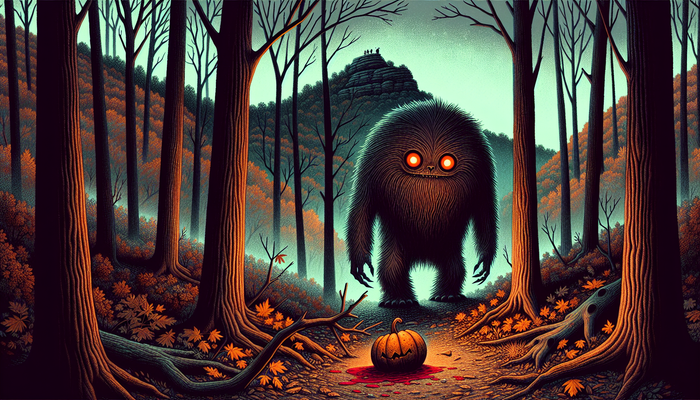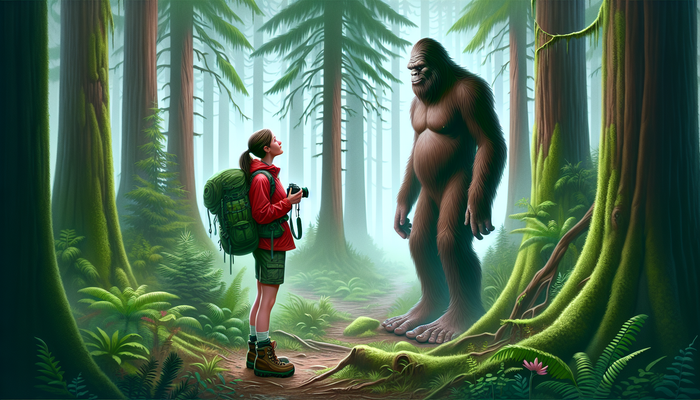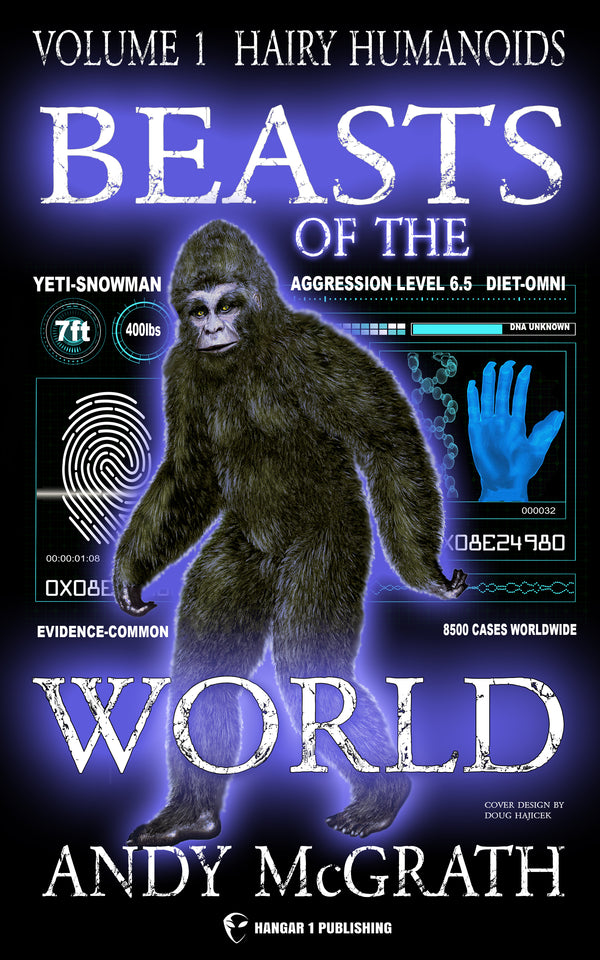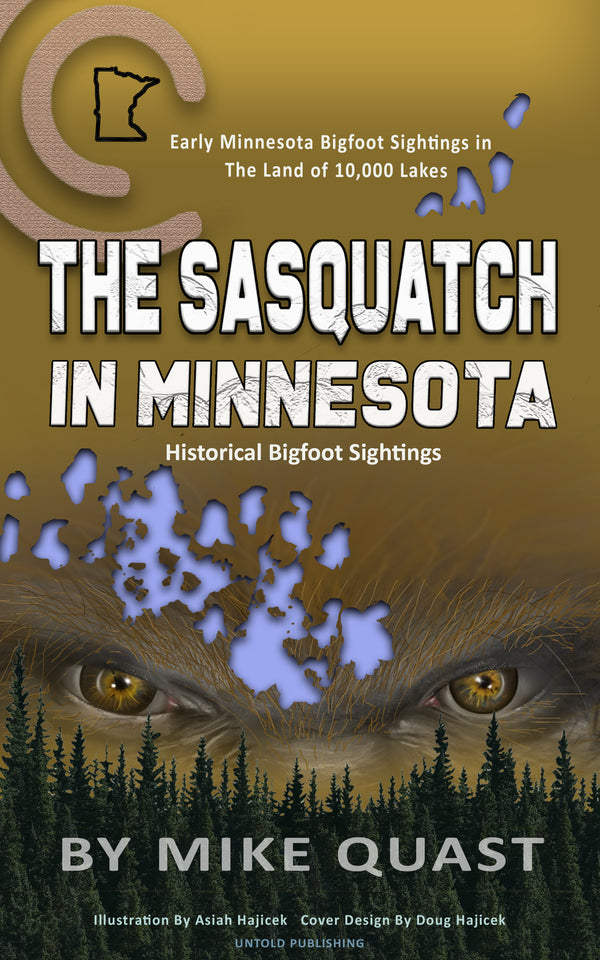The Borrego Sandman Mystery

By Oliver Bennett, Bigfoot Researcher and Teacher
The vast, arid expanse of the Anza-Borrego Desert State Park holds many secrets, but none as intriguing as the legend of the Borrego Sandman. This enigmatic creature has captured the imagination of locals and adventurers alike for over a century, leaving behind a trail of mystery and intrigue that beckons to be unraveled. As a researcher and scholar of cryptozoology, I find myself irresistibly drawn to this tale, compelled to delve into its history, sightings, theories, and cultural impact in an effort to shed light on one of Southern California's most enduring cryptid mysteries.
The Legend of the Borrego Sandman
Physical Description
The Borrego Sandman is a formidable figure, said to stand an imposing 8 feet tall and weigh up to 400 pounds. Witnesses describe the creature as being covered in shaggy white fur, a striking contrast to the sun-scorched desert landscape it calls home. Perhaps most unnerving are the Sandman's eyes, which are said to glow an eerie red, piercing through the darkness of the desert night.
In many ways, the Borrego Sandman bears a striking resemblance to the more well-known Bigfoot or Sasquatch. Both are described as large, ape-like creatures that walk upright on two legs. However, the Sandman's white fur and desert habitat set it apart, leading some to speculate that it may be a distinct subspecies of Bigfoot, one that has adapted to the harsh, arid conditions of the Anza-Borrego Desert.
Native American Lore
The legend of the Borrego Sandman is deeply rooted in the lore of the region's Native American tribes. The Cahuilla people, who have inhabited the area for thousands of years, spoke of "Hairy Devils" - foul-smelling, man-like beasts that were to be avoided at all costs. These creatures were said to roam the desert, lurking in the shadows and striking fear into the hearts of all who encountered them.
The fact that tales of these "Hairy Devils" predate the arrival of European settlers suggests that the legend of the Borrego Sandman has ancient origins. It is possible that the Cahuilla people were describing real creatures that they had encountered in the desert, beings that were later incorporated into their oral traditions and passed down through generations.
Early Settler Reports
As European settlers began to trickle into the Anza-Borrego region in the 1800s, they too began to report sightings of strange, ape-like creatures in the desert. These accounts often described the beings as "wild men," covered in hair and walking upright on two legs. Some even claimed to have found large, human-like footprints in the sand, further fueling speculation about the existence of the Borrego Sandman.
It is interesting to note that these early settler reports coincide with the rise of Bigfoot sightings in other parts of North America. The mid-1800s saw a surge in interest in "wild men" and "ape-men," with newspapers across the continent publishing sensational stories about these mysterious creatures. It is possible that the legend of the Borrego Sandman emerged as a localized version of this broader cultural phenomenon, with the desert setting adding a unique twist to the tale.
Historical Sightings and Encounters
1876: Prospector Turner Helm
One of the earliest recorded encounters with the Borrego Sandman occurred in 1876, when a prospector named Turner Helm claimed to have come face-to-face with the creature near the ominously named Deadman's Hole. According to Helm's account, the Sandman was highly aggressive, advancing on him in a threatening manner. Helm attempted to communicate with the beast in various languages, but to no avail. In the end, he was forced to brandish his rifle to scare the creature off, narrowly escaping what he believed to be a potentially deadly encounter.
Helm's story is notable for several reasons. First, it establishes the Borrego Sandman as a potentially dangerous creature, one that is not afraid to confront humans. Second, it suggests that the Sandman is not a mere legend, but a flesh-and-blood being that leaves tangible evidence of its presence in the form of footprints. Finally, it raises questions about the creature's intelligence and ability to communicate. If Helm's account is to be believed, the Sandman did not respond to any of the languages he tried, suggesting that it may have its own unique form of communication.
1888: Hunters Charles Cox and Edward Dean
A decade after Helm's encounter, two hunters named Charles Cox and Edward Dean claimed to have not only seen the Borrego Sandman, but to have actually killed one. According to their story, they had set out into the desert to track down the creature, believing it to be responsible for a string of unsolved murders in the area. The victims had been brutally torn apart, leading Cox and Dean to suspect that an animal, rather than a human, was to blame.
After a grueling trek through the desert, the hunters finally caught up with their quarry. They described the creature as a massive, ape-like beast, covered in dark fur. In a dramatic confrontation, Cox and Dean allegedly opened fire, killing the Sandman. They then claimed to have shipped the creature's body back to San Diego, where it was to be put on public display as proof of their incredible find.
However, this is where the story takes a bizarre turn. According to Cox and Dean, the body of the Sandman mysteriously vanished en route to San Diego, never to be seen again. This has led many to question the veracity of their tale. Some believe that the hunters fabricated the story for attention, while others speculate that the body was indeed real, but was intercepted and hidden by those who wished to keep the existence of the Borrego Sandman a secret.
1939: Anonymous Store Owner and Prospector
In 1939, an anonymous store owner and prospector had a terrifying encounter with not just one, but a whole group of Borrego Sandmen. The man claimed that he was camping near Borrego Sink when he was suddenly surrounded by a pack of upright-walking apes. He described the creatures as being covered in white fur, with glowing red eyes that pierced the darkness.
Interestingly, the man noted that the creatures seemed to be afraid of his campfire. They kept their distance, circling the perimeter of his camp but never coming too close to the flames. This detail adds an intriguing layer to the Borrego Sandman legend, suggesting that the creatures may have a fear or aversion to fire.
The store owner's story is also notable for the sheer number of creatures involved. While most Sandman sightings involve a solitary creature, this account describes a whole group, possibly even a family unit. This raises questions about the social structure and behavior of these mysterious beings. Do they live in groups? Do they have a hierarchical system? These are questions that remain unanswered, but the 1939 encounter provides tantalizing clues.
1964: Victor Stoyanow's Discovery
In 1964, a man named Victor Stoyanow made a discovery that would reignite interest in the Borrego Sandman. While exploring the desert, Stoyanow came across a series of large, human-like footprints in the sand. The prints measured an astonishing 14 inches in length and 9 inches in width, suggesting a creature of enormous size.
Stoyanow was so impressed by his find that he made plaster casts of the prints and took photographs of the site. He believed that he had found irrefutable evidence of the Borrego Sandman's existence, and he was eager to share his discovery with the world.
Unfortunately, Stoyanow's evidence has since been lost. The plaster casts and photographs have disappeared, leaving only his testimony as proof of the encounter. Some have suggested that Stoyanow may have fabricated the story, or that the prints could have been made by a human wearing oversized shoes. However, those who knew Stoyanow described him as a credible and honest man, not prone to exaggeration or deceit.
1968: Harold Lancaster's Close Encounter
Perhaps the most detailed and compelling account of a Borrego Sandman sighting came from Harold Lancaster, a prospector who claimed to have had a face-to-face encounter with the creature in 1968. Lancaster was exploring the desert east of Borrego Springs when he spotted a large, upright figure walking in the distance. At first, he assumed it was another prospector, but as he drew closer, he realized that he was looking at something far more unusual.
Through his binoculars, Lancaster saw what he described as a "real giant ape-man." The creature was covered in hair and walked with a lumbering gait, its long arms swinging at its sides. Lancaster watched in amazement as the Sandman approached, growing more and more nervous as it drew closer.
Fearing for his safety, Lancaster drew his .22 pistol and fired a warning shot into the air. The sound of the gunshot seemed to startle the creature, causing it to jump and turn its head in Lancaster's direction. For a moment, the two stared at each other, man and beast, each trying to make sense of the other.
In the end, Lancaster chose not to shoot the Sandman, even though he felt that his pistol would have been little more than a "peashooter" against such a massive creature. Instead, he watched as the Sandman turned and fled, disappearing into the desert landscape as quickly as it had appeared.
Lancaster's encounter is notable for several reasons. First, it provides one of the most detailed descriptions of the Borrego Sandman's physical appearance, down to its lumbering gait and long, swinging arms. Second, it suggests that the creature is not necessarily aggressive towards humans, as it did not attack Lancaster even when it had the opportunity to do so. Finally, it raises questions about the Sandman's intelligence and self-awareness. The fact that it seemed to recognize the sound of the gunshot and respond to it suggests a level of cognition that goes beyond mere animal instinct.
Physical Evidence and Theories
The 1962 Footprint Cast
Despite the numerous sightings and encounters with the Borrego Sandman over the years, physical evidence of the creature's existence remains frustratingly elusive. One of the most tantalizing pieces of evidence is a footprint cast allegedly taken by a retired police officer in 1962.
The cast, which measures 14 inches in length and 9 inches in width, is said to have been made from a fresh track found in the desert sand. It clearly shows the imprint of a large, humanoid foot, complete with four distinct toes. Interestingly, the print lacks any sign of claws, suggesting that the Borrego Sandman is not a mere animal, but a primate of some kind.
The 1962 footprint cast is currently on display at the International Cryptozoology Museum in Portland, Maine, where it has become a popular exhibit among Bigfoot enthusiasts. However, some have questioned the authenticity of the cast, noting that it could have been fabricated by someone with a knowledge of special effects or sculpture.
Theories and Speculations
The physical evidence for the Borrego Sandman may be scant, but that hasn't stopped researchers and enthusiasts from speculating about the creature's true nature. One popular theory is that the Sandman is a previously undiscovered primate species, one that has adapted to life in the harsh desert environment.
Proponents of this theory point to the creature's ape-like appearance and lack of claws as evidence of its primate origins. They suggest that the Sandman may be a relict population of an ancient ape species, one that survived the ice ages by adapting to the arid conditions of the Anza-Borrego Desert.
Another theory is that the Borrego Sandman is a subspecies of Bigfoot, a desert-dwelling population that has evolved to cope with the unique challenges of life in the sand and sun. Supporters of this idea note the many similarities between the Sandman and classic Bigfoot descriptions, including their large size, upright posture, and ape-like features.
Some researchers have even suggested that the decline in Borrego Sandman sightings in recent years may be due to the creature's migration to the nearby mountains. They speculate that the Sandman may have been driven out of its desert habitat by human encroachment or changes in the local ecosystem, and that it now resides in the more hospitable mountain regions to the north.
Of course, there are also those who believe that the Borrego Sandman is nothing more than a hoax or a case of mistaken identity. They argue that the sightings can be explained by a combination of factors, including misidentification of known animals, hallucinations brought on by the harsh desert conditions, and outright fabrication by attention-seekers.
The Borrego Sandman in Popular Culture
The Ranchita Yeti Statue
Despite the lack of concrete evidence, the legend of the Borrego Sandman has taken on a life of its own in popular culture. One of the most visible examples of this is the Ranchita Yeti statue, which stands outside the Montezuma Valley Market in the tiny town of Ranchita, California.
The statue, which was erected in 2007, depicts a large, ape-like creature with shaggy fur and a menacing expression. It was commissioned by the market's owner, who wanted to create a roadside attraction that would draw visitors to the area.
The Ranchita Yeti has become a popular photo opportunity for tourists and cryptid enthusiasts alike. Many see it as a tongue-in-cheek tribute to the Borrego Sandman legend, a way of acknowledging the creature's place in local folklore while also having a bit of fun with the idea.
"Mysteries at the Museum" Episode (2019)
In 2019, the Borrego Sandman received national attention when it was featured on an episode of the Travel Channel series "Mysteries at the Museum." The show, which explores unusual and often overlooked artifacts from museums around the world, devoted a segment to the 1962 footprint cast and the history of the Sandman legend.
The episode brought the Borrego Sandman to a wider audience, introducing the creature to viewers who may have never heard of it before. It also sparked renewed interest in the legend among cryptozoology enthusiasts, many of whom saw the show as validation of their belief in the creature's existence.
Connections to Other Regional Cryptids
The Borrego Sandman is not the only mysterious creature said to roam the deserts of Southern California. Over the years, there have been numerous reports of other cryptids in the region, many of which bear striking similarities to the Sandman.
One of the most well-known of these is the "Yucca Man," a Bigfoot-like creature said to inhabit the area around Joshua Tree National Park. Like the Sandman, the Yucca Man is described as a large, upright-walking ape with shaggy fur and glowing eyes. Some researchers have suggested that the two creatures may be one and the same, or at least closely related.
From Bigfoot to UFOs: Hangar 1 Publishing Has You Covered!
Explore Untold Stories: Venture into the world of UFOs, cryptids, Bigfoot, and beyond. Every story is a journey into the extraordinary.
Immersive Book Technology: Experience real videos, sights, and sounds within our books. Its not just reading; its an adventure.



























